Build Design Systems With Penpot Components
Penpot's new component system for building scalable design systems, emphasizing designer-developer collaboration.

Startups, Wanderlust, and Life Hacking — Medium | Gosia Zelba

Let’s imagine a possible situation. Two brands with similar target audiences, with reliable and well-developed services and equally awesome customer service.
One of these brands is your brand. The other is your competitors’.
So, which one do you think the users should choose?
You may think it’s the cheaper one. But actually, research shows that low prices may sometimes deter users from buying from the cheap brand and make them choose more expensive brands instead.
You may think it’s the one that’s been on the market longer. But in fact, many new products, such as Netflix or Spotify became blockbusters in an instant, outperforming the older players by a wide margin.
Or maybe you think it all just has to be based on the user’s individual preferences. But as much as we like to think of ourselves and our users as unique individuals, social psychologists will tell you that people often tend to behave in certain, predictable ways.
And it can be predicted that the brand the client will choose is the one he or she trusts more.
Trust is one of the hardest things to earn and the easiest to lose and it’s definitely not acquired without a good reason. But there are some tried and tested methods that every brand can use to inspire customer trust, increase engagement and turn more leads into sales. What are they?
When users first encounter your product or service, they often don’t know much how it works, what it looks like, how much it costs… Sometimes they don’t even know what it does! Make sure you leave no such blindspots, because transparency and information breed trust. The more information about the product or service, the more willing they are to trust you with their money.
According to the study reported by Adweek, more than 80% of buyers do online research before purchasing a product. What is more, more than 40% of these buyers are methodical in their approach — they analyze available options and make decisions based on facts and data. So, think about value you want to provide, support with numbers and say it!
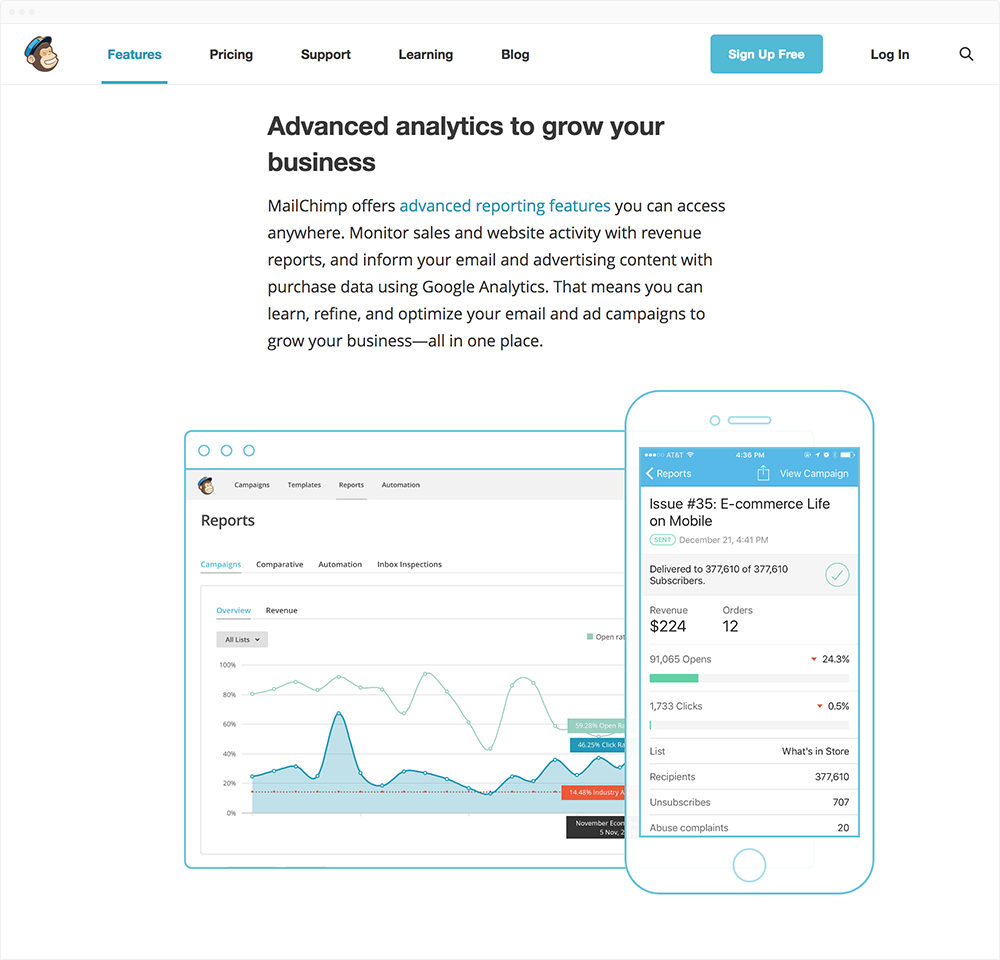 See how Mailchimp does this? One by one feature description, a link to get more details and a real-life image.
See how Mailchimp does this? One by one feature description, a link to get more details and a real-life image.
👉 Tip: Not sure how to create a knowledge base?
Look for software such as KnowledgeOwl, Zendesk or Freshdesk. These apps won’t only help you to build your KB, but they come together with great knowledge bases telling you how to do this step by step!
Product pages or knowledge bases are effective trust builders, but they have a serious drawback — not everybody will visit them. But there are pages that almost everybody visits on a regular basis. Think Twitter. Facebook. Instagram. They can all help you build trust with visitors who have never heard about you. Those who follow your social media, whether actively or not, show that they endorse your brand. Their endorsement can help you convince even more people to trust you. What you need is an account, some fairly regular activity and an ever-expanding circle of followers.

As Timothy Alexander says in his article on social media,
”Social media is not just a way to sell to your customers. It is a way to connect, create a community, and build trust and loyalty. (…) Start relating to customers and stop selling to them. When you build trust and loyalty, the sales will come.”
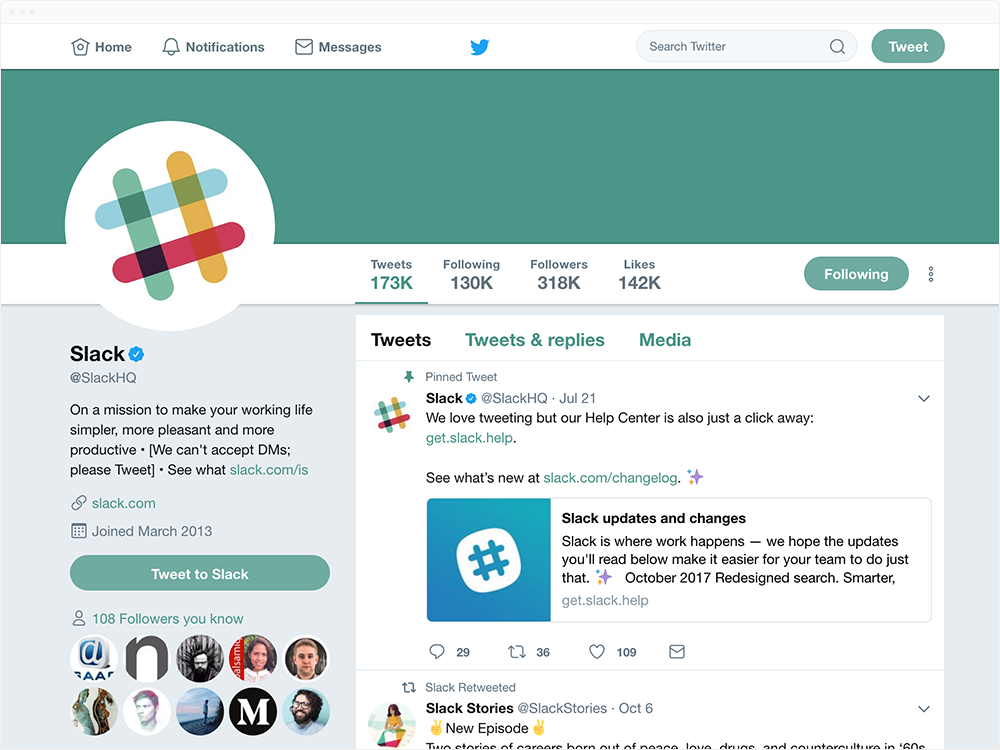 Noticed the number of likes and shares there? Slack surely knows how to do this right!
Noticed the number of likes and shares there? Slack surely knows how to do this right!
Let’s face it. Users are often wary of glorifying descriptions of your amazing product ad its perfect features — especially if your’re the one writing them! You may be an expert on your soft, but your not an independent expert — at least not in the eyes of your clients to be, who may perceive you as some mischievous money-driven owner just wanting to sell and earn more. Your present clients, on the other hand, come across to as being on the same side as they are, only being able to say a lot about their true experience with your soft.
Nothing works quite as well as real-life experience, so if clients had a happy experience with your app or website, make sure they say this out loud. If a review is relatable and clearly shows the benefits of using your app — it’s certain to build trust among the readers. And it may be even more effective when it’s posted on a third-party site rather than your own.
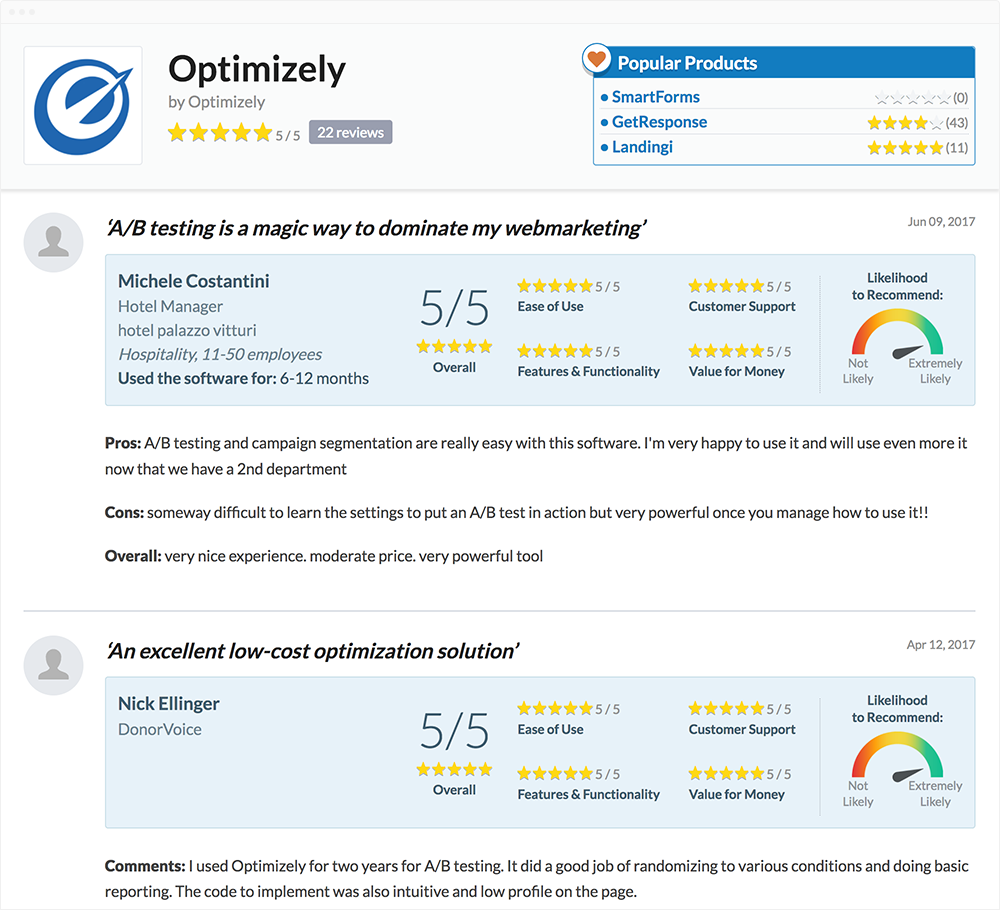 Capterra’s reviews really help to get valuable information about the product and review writer.
Capterra’s reviews really help to get valuable information about the product and review writer.
👉 Tip: Try to get to as many directories and review websites as you can.
The more lists feature your brand, the greater the chance that your prospective user will spot it and trust it! Here are some SaaS Directories & Review Websites and How to Get Listed There.
There’s one thing that works better than a review. And this is a review written by the key player or a famous expert in your field. If such a person thinks your service great you’ll soon have their fains and followers (and soon your clients) — thinking that too!
Testimonials are great for creating trust in any company. As Yoast reports, testimonials influence the perceived trustworthiness of an online store more than trust seals or even this store’s overall reputation! But in order to earn trust they need to be valuable for readers. Sometimes even negative feedback can work.
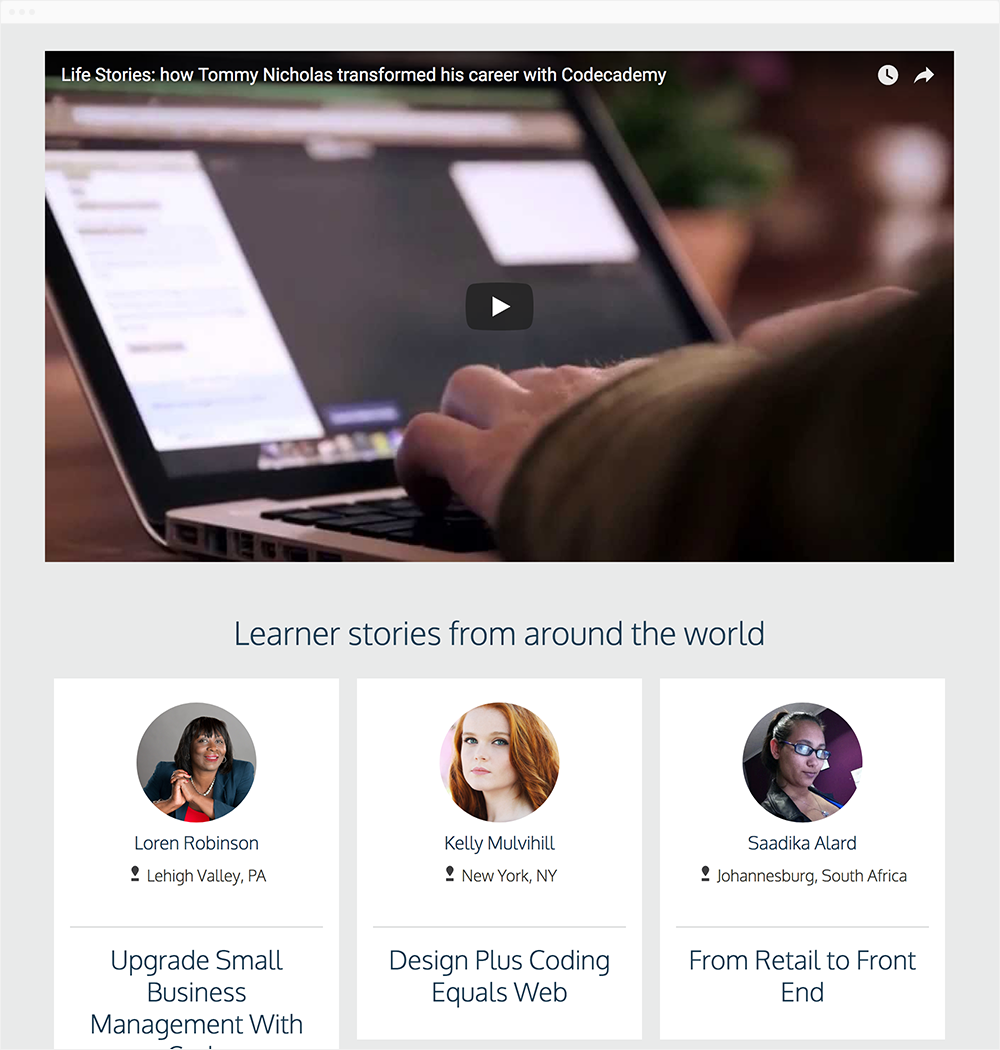 Codecademy has it more captivating, with video testimonials and personal stories
Codecademy has it more captivating, with video testimonials and personal stories
Many visitors to your site are just looking around, gathering information, not trusting and ready enough to subscribe, sign up for a trial or buy a product or serivce. But if they saw other people doing just that… Wouldn’t they feel more secure and more willing to trust you?
Oh yes, they would. Some simple tricks psychologists would call social proof can do wonders for you here by showing that so many other visitors are achieving your conversion aims this instant! Similar effects can be achieved if you display information about what has currently been done to improve your service… Or just display system status, like Typeform does. More trust activated in… 3… 2… 1… .
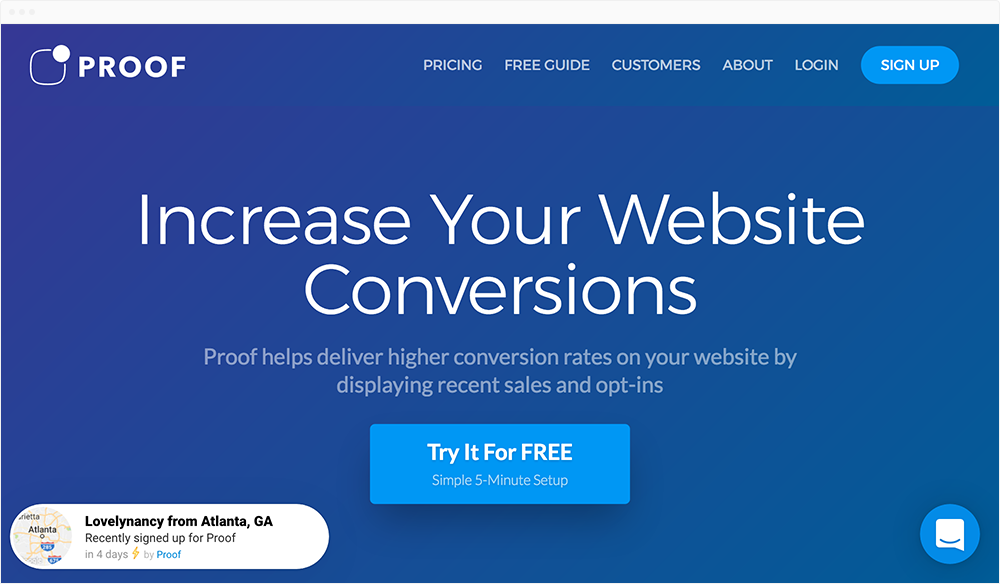 Proof helps to increase trust by notifying your visitors what other users have done
Proof helps to increase trust by notifying your visitors what other users have done
👉 Tip: You can use these apps to display activity notifications:
1. fomo — with fomo you can display both what your users did (signed up, upgraded to a higher plan) and what you did (updates to the soft)
2. Proof —you can display user activity notifications and setup is a matter of mere minutes
One of the most common visitor anxieties is business reliability, and this is even more prominent in SaaS companies, which store sensitive data in the cloud. The same is true for online payments and having to provide all these personal details… These can often be a deciding factor that stops a potential client from trusting you with their money.

Many studies similar to this one suggest a trust seal ensuring secure payment or a trust-inducing logo can make all the difference between buying your product and not doing so. Assure your users that their data is encrypted, that the page is secure and payment method safe to boost trust levels instantly.
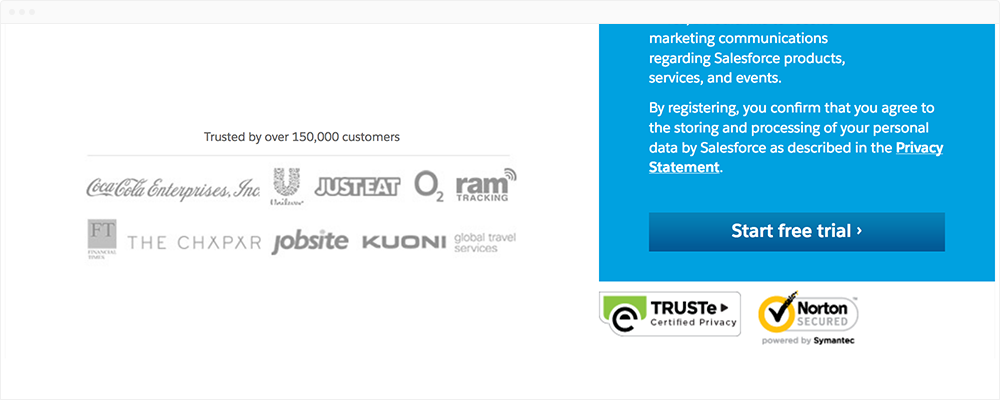 Salesforce places two security seals right next to a CTA button.
Salesforce places two security seals right next to a CTA button.
👉 Tip: Put your seals in the right place.
Simply having a trust seal on your website or landing page can improve consumer confidence, but their location is just as important. Moving trust seals closer to lead capture fields will help to evoke more trust in users who are entering sensitive information. Placing then in the header or footer makes them always visible to your potential buyers.
Trust. If your prospective users don’t trust your product and your brand, they simply won’t turn into clients. These 6 methods can help you quickly increase your clients’ confidence in your brand, increase engagement and generate more sales.
But there’s one more thing that can help you and this is understanding your users: their needs, expectations and fears. If you know what these are, you can respond to them adequately with your own trust-building strategy.
For example, if your users are concerned about paying on-line, user notifications and badges are probably a must. If they are afraid that your product will not be easy to use — make sure you have plenty of reviews that say that it is! If the product is not popular yet and they may fear the unknown — build your social network or try to get a few testimonials from a popular / respected client. Here’s a simple 9-step framework that can help you get to know your users better —(you can use it write your UVP, too!):
User Centered Design Canvas – First UX tool combining user needs with business goals
Did you try any of these methods for your website? Or have you used others that have been successful? I’ll be happy to read about your experience in the comments! 🙂


How to Make Users Trust a SaaS was originally published in The Startup on Medium, where people are continuing the conversation by highlighting and responding to this story.
AI-driven updates, curated by humans and hand-edited for the Prototypr community